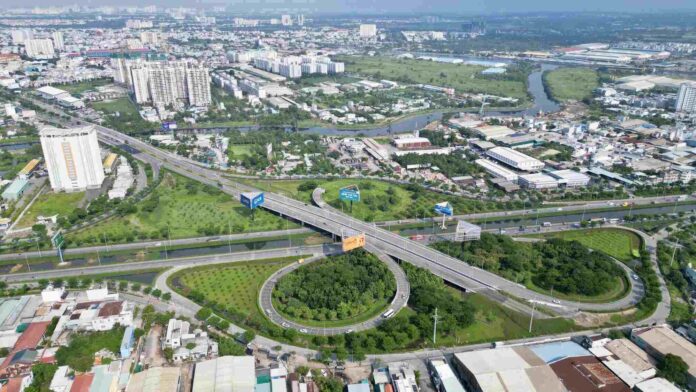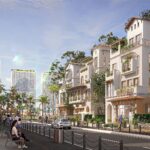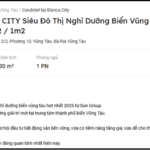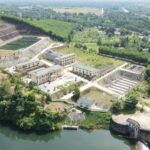Western HCMC’s infrastructure has become synchronized…
The western districts of Ho Chi Minh City, including Binh Tan, Tan Binh, District 8, District 6, District 12, Go Vap, and Tan Phu, have witnessed a synchronized development in their transportation infrastructure and well-planned urban policies. The real estate market in these areas has undergone a remarkable transformation over the years, largely driven by the region’s dynamic infrastructure growth.
Major roads such as Vo Van Kiet Boulevard, Kinh Duong Vuong Street, Hong Bang Street, Ten Lua Street, and the Ho Chi Minh City-Trung Luong Highway have been in place and continuously upgraded, providing a seamless transportation network for the western part of the city.
Recently, the Ho Chi Minh City Department of Construction was assigned by the city’s People’s Committee to prepare a pre-feasibility study and make adjustments to the project “Construction of the East-West Axis (Vo Van Kiet) extension from National Highway 1 to Long An province”. This project, with its starting point at the end of the existing Vo Van Kiet Boulevard (intersecting with National Highway 1 in An Lac – Binh Tan) and ending in Duc Hoa, Long An, has caught the attention of many, as it is expected to bring significant benefits to the real estate market in the surrounding areas.
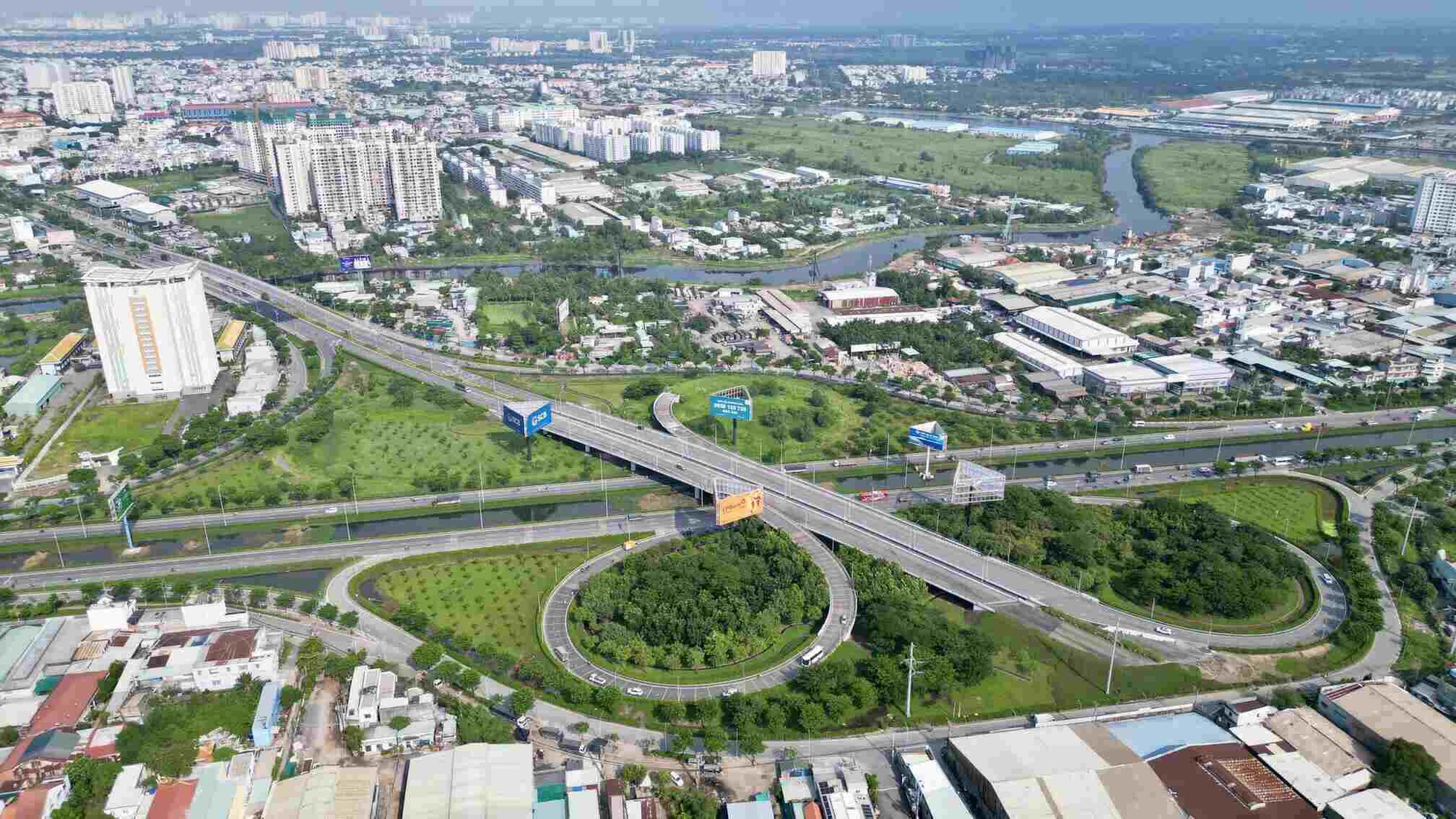
The East-West Axis is a key infrastructure project that will foster strong regional connectivity and boost socio-economic development in the entire region.
Currently, Vo Van Kiet Boulevard, with a width of 60 meters and a length of approximately 13 kilometers from Calmette Bridge (District 1) to the intersection with National Highway 1A (Binh Chanh district), has been operational since 2009 and is considered a vital artery, linking Ho Chi Minh City with key economic regions in the south. Extending this route to Long An will further facilitate socio-economic progress and real estate market growth.
In a previous sharing, Mr. David Jackson, General Director of Avion Young Vietnam, mentioned that real estate projects located near the Vo Van Kiet route would gain long-term value due to their easy connectivity to the city center, making them convenient for both work and business. The expansion of roads such as An Duong Vuong – Phan Anh – Binh Long – Huong Lo 3, the connection between Phan Dinh Thong and An Duong Vuong, and the upcoming extension to Long An have collectively contributed to a synchronized infrastructure development in the western districts of Ho Chi Minh City, thereby stimulating the region’s real estate market.
Additionally, the Metro Line 3 project is a key component of the city’s urban transportation planning, directly impacting the real estate market in the western part of the city in the future. The project is divided into two main branches: Line 3A and Line 3B. Line 3A (Ben Thanh – Tan Kien) is expected to commence its first phase in 2026, with a total length of about 11 kilometers, encompassing 11 underground stations and 3 elevated stations. The second phase is planned for the period between 2029 and 2034.
In parallel, the Metro Line 6 project, connecting Ba Queo Station (Tan Phu District) to Phu Lam Roundabout Station (District 6), is also in the pipeline. Real estate projects near these metro lines will reap direct benefits, and residents’ travel time to the city center or other areas will be significantly reduced.
Furthermore, the Ho Chi Minh City Department of Transport has proposed prioritizing the investment in the intersection of National Highway 1 – Road No. 7 – Road No. 18 (Binh Tan District) and upgrading and expanding Nguyen Thi Tu Road, connecting Binh Tan and Binh Chanh districts, with a length of 2.4 kilometers. Additionally, a flyover is suggested to be constructed at the intersection of Nga Tu Xa with a capital investment of VND 2,400 billion. These infrastructure projects are prioritized to alleviate traffic congestion and transform the urban landscape of western Ho Chi Minh City.
…But there is a shortage of high-quality housing supply
Despite substantial infrastructure investments and a growing demand for high-quality housing, the western districts of Ho Chi Minh City have seen very few premium townhouses entering the market in recent years. This scarcity is expected to drive up prices further.

Landed property prices in the western districts continue to rise due to limited new supply. (Source: Batdongsan.com.vn data)
The western districts of Ho Chi Minh City have experienced a continuous increase in population due to high immigration rates. There is a substantial demand for both residential and commercial spaces in the area. However, the supply of high-quality housing that meets the needs of high-income earners is very limited. While the western districts have benefited from advanced infrastructure development, the supply of commensurate housing has lagged.
Upon investigation, it was found that there is a severe shortage of commercial townhouses (combined residential and commercial use) or adjacent villas in areas such as Binh Tan, Tan Phu, Binh Tan, Go Vap, and District 8. Binh Tan, in particular, has the second-largest population in the city, a significant number of high-net-worth individuals, and substantial accumulated wealth. However, finding luxury or high-end real estate to meet the demands of a quality lifestyle in this area is extremely rare. The district primarily offers affordable apartments and land plots that were released a long time ago.
Currently, The Sholi project is the only source of commercial townhouses (combined residential and commercial use) in the area. With 90 townhouses located on the An Duong Vuong street front (Binh Tan district) under construction, this project has witnessed steady price increases due to the lack of similar products in the vicinity.

The supply of commercial townhouses is scarce in the western districts of Ho Chi Minh City’s real estate market.
In Go Vap district, the supply of premium townhouses is also very limited. Apart from the Cityland Park Hills project, which has been on the market for quite some time, there is no available land for developing high-end housing. Meanwhile, the supply of individually built houses (constructed at the owner’s discretion) in this area, which used to be abundant, is gradually diminishing. This scarcity of supply has resulted in continuous increases in landed property prices over the years.
It has been observed that, for many years, the western districts of Ho Chi Minh City have lacked well-planned and distinctive high-quality townhouse projects, despite the substantial demand. This presents a housing challenge for the region. While benefiting from infrastructure development, the lack of commensurate project development hinders the fulfillment of homebuyers’ needs.
Notably, Binh Tan district, with its convenient access to District 1 and District 3 via Vo Van Kiet Boulevard, holds significant potential for high-quality townhouse developments. This area is expected to attract capital inflows from homebuyers relocating from the city center, offering a solution to the demand for quality housing while still providing relatively softer prices compared to the city center. The area holds long-term potential, but these advantages have not been fully exploited.
The continuous price fluctuations of townhouses in the western districts over the years also reflect the impact of limited supply, driving up prices. Moreover, when compared to the overall Ho Chi Minh City market, the western districts are still considered attractive due to their vast land banks, lower price levels, and promising growth potential. Additionally, the current phase of robust infrastructure development further stimulates investment inflows, pushing prices upward.
The Grand Unveiling of the First Three Residential Towers at Blanca City
In June 2025, Sun Property, a proud member of the Sun Group conglomerate, unveiled the Blanca precinct, comprising six towering residential towers within the pristine “White City” of Blanca City.
Luxury Living by the Sea: Redefining Vung Tau’s Property Landscape.
The vacation apartment prices in Vung Tau are setting a new benchmark, with recent projects boasting rumored prices of up to almost VND 100 million per square meter. This indicates a noticeable surge in the pricing competition within the resort real estate sector, as evident from various property listings.
The Stalled Water Treatment Plant: A $10 Million Dollar Blunder?
The water treatment plant project in Huong Khe district, Ha Tinh province, has faced significant delays, missing its completion deadline twice. Despite the setbacks, the project remains a key initiative with an important goal: to provide clean and accessible water to the local community. With a renewed sense of purpose and dedication, the team is working tirelessly to overcome challenges and ensure a successful outcome.


























